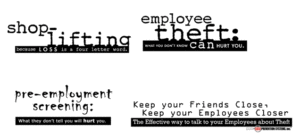 Do you REALLY know how to stop shoplifters? I mean, really know? Your Checkpoint System is only half of the strategy. You spent the money, put the labor/time into using labels and tags but after the newness wears off, are you still having more losses than you want?
Do you REALLY know how to stop shoplifters? I mean, really know? Your Checkpoint System is only half of the strategy. You spent the money, put the labor/time into using labels and tags but after the newness wears off, are you still having more losses than you want?
As a customer of Loss Prevention Systems you have more. Because you bought your system from us and purchase tags/labels from us, we will train you and your staff in any or all of our awesome FREE, LIVE webinars:
 Yes, we will conduct these webinars privately for you. As reasonably often as you need. Change in staff, new hires, new supervisor, new manager, refresher training, one person or fifty…. Just call and schedule it.
Yes, we will conduct these webinars privately for you. As reasonably often as you need. Change in staff, new hires, new supervisor, new manager, refresher training, one person or fifty…. Just call and schedule it.
You see, I believe that the Checkpoint System and Alpha High Theft Solutions equipment is as good as the staff that is handling it. So these webinars are not about how to use the equipment but about how to deter the shoplifters in the first place and what to do when you do catch one. I cover your stores policy (or help you design one), how to approach a suspected shoplifter and deter them, how to handle an alarm from the Checkpoint System, your State’s laws and much more.
My 30 years as an LP professional starting as a Police Officer, Store Investigator, District LP Manager, Regional LP Manager and the Director of LP for two major retailers, give me a vast amount of experience to draw on to help you solve your problems. Think of Loss Prevention Systems as your LP Department. All of that because you are our good customer!
My goal is to reduce YOUR losses. If LPSI can do that, then we are all happy.
So call or email us, get one scheduled before you lose any more merchandise to thieves.
 There’s been some news swirling around the LP world for a few weeks now about California and some new laws that the state has passed. Basically, the state raised the threshold for a felony theft to $950. The article hinted that shoplifting has increased in the major retail stores and calls for shoplifting cases have increased by 25% to the LAPD. The article blamed the new legislation for this. Here’s a link to that article if you’d like to read it. (
There’s been some news swirling around the LP world for a few weeks now about California and some new laws that the state has passed. Basically, the state raised the threshold for a felony theft to $950. The article hinted that shoplifting has increased in the major retail stores and calls for shoplifting cases have increased by 25% to the LAPD. The article blamed the new legislation for this. Here’s a link to that article if you’d like to read it. ( It’s no big secret that I can’t stand a thief; I did make a career out of catching them. Shoplifters really get under my skin, but employee theft really fires me up. You put people to work, give them opportunity to grow and instead of putting in the long hours, hard work and dedication needed to move forward, they steal from you. They betray your trust, slap you in the face and take money out of your pocket and food off your family’s table. Will you ever stop employee theft completely? Probably not. You can, however, minimize the risk.
It’s no big secret that I can’t stand a thief; I did make a career out of catching them. Shoplifters really get under my skin, but employee theft really fires me up. You put people to work, give them opportunity to grow and instead of putting in the long hours, hard work and dedication needed to move forward, they steal from you. They betray your trust, slap you in the face and take money out of your pocket and food off your family’s table. Will you ever stop employee theft completely? Probably not. You can, however, minimize the risk. Whether you’re a small one store business, or a large chain store, loss prevention awareness training for your teams cannot only protect against criminal acts, but also make a direct and positive impact on your bottom line. There is an inherent value in awareness training that lots of managers just don’t take advantage of. The core of any successful loss prevention program is not how many shoplifters are caught, nor is it how many employees were arrested; it’s training and awareness of your store teams. We are called loss “prevention,” not loss “reaction,” right? So how do you persuade your managers to see the value?
Whether you’re a small one store business, or a large chain store, loss prevention awareness training for your teams cannot only protect against criminal acts, but also make a direct and positive impact on your bottom line. There is an inherent value in awareness training that lots of managers just don’t take advantage of. The core of any successful loss prevention program is not how many shoplifters are caught, nor is it how many employees were arrested; it’s training and awareness of your store teams. We are called loss “prevention,” not loss “reaction,” right? So how do you persuade your managers to see the value?

